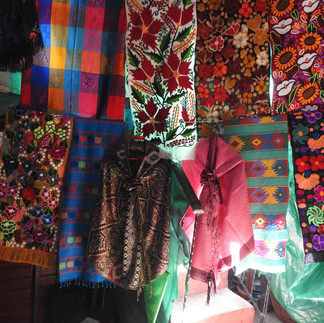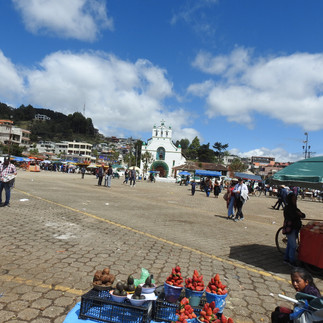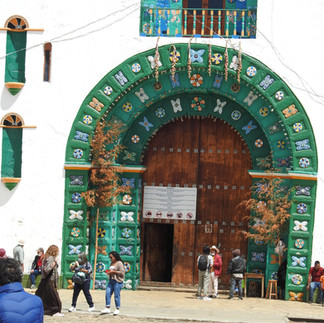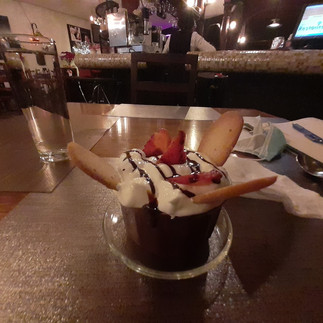Zinacantán and San Juan Chamula
- KB Cook

- Mar 2, 2022
- 5 min read

Saturday began with a 9:30 pickup from the café on the “French” plaza, which was just down a block from the hotel. Arriving early, I got a café Americano con leche plus a shot of cocoa with a brownie and wrote a bit in my journal. I’d picked up water and bananas from the market across from the hotel, so I was controlling my nighttime leg cramps. We were collected and away on time: two Mexican couples, a Spanish-speaking couple from Italy, and the English-speaking contingent: a German couple, a single female dentist from Belgium and me. Our driver’s name was Miguel, but I didn’t catch the guide’s name.
Our first stop was the town of Zinacantan, maybe 90 minutes drive west through hills. Known for its weaving collectives, the tour stopped first at one where we were shown traditional weaving, many woven clothing options, offered by local women (who understood the hard sell.) We were treated to some local pox, and in a smaller separate room, had the option to have fresh tortillas we stuffed with cheese, beans and an awesome salsa. Extremely tasty. I resisted getting a pullover, using the lack of my color preference (azul) for an excuse.
Once outside, we were given a half hour to visit the two churches on the square. The larger of the two, dedicated to St Michael, was airy and bright, with banners draped over the seating area, hanging from the ornate wooden ceiling. Some of the smaller shrines lining the sides walls included pottery animals, probably representing the indigenous gods; an interesting presence in an “established” church.
The smaller church was located in a corner of the square surrounding the larger building. Without pews, was seemed to be a dining table sat in the center of the nave, while multiple floral arrangements were festooned at the altar end of the space. Solid colored banners hung progressively from front to back. This church was dedicated to San Lorenzo.
The ten of us, with the guide and driver all boarded the van and headed northeast to Chamula. I suspect they were being frugal, as we wound up in free parking about a 15-minute walk to the church. Our walk took us by the cemetery, which the guide enlightened us: if there is a stone above the burial spot, you have money or power. Most sites were mounds of soil, perhaps with some large stones as a border. Flowers and marker crosses were everywhere. Small house-like structures held candles, photographs and small statues of saints. An old derelict building, likely a former church, sat in the far corner of the space, watching over these dead buried bodies. Crosses are color coded: youngster, adult, clergy and animals.
A bit further down the road we came to a very large open space, a stone-paved plaza in front of the Church of San Juan Bautista. The open-air market would occupy this space, but not on a Saturday. As we approached the church entry, the guide went to purchase tickets for our admissions. When he returned, we were again advised that photography of any kind was prohibited, with a fine of 3,900$Mex (about $200) and confiscation/destruction of the equipment if caught. I simply turned my camera off, and with my phone, put all into my backpack.

Inside, the marble tiled floor is mostly covered by long-needled pine cuttings, with spaces cleared in front of shrines for the placement of candles (a votive candle provides hot, liquid wax for the tapers to be dipped into, before affixing on the marble.) A shaman will spill either chicken blood or Coca Cola on the flooring as prayers are said. The penitents remain seated on the marble as the candles are lined up and lit, during the invocations, and for a period afterwards. The space is heavy with smoke, as there are many shrines along the 200-feet of side walls, as well as the main altar end. Timbers, shaped as a cross, lean against the walls near the corners. Many males stand to the side, observing the undertakings and monitoring the crowds that come in to observe.
After I’d made my circuit and observed a ceremony, I went back outside. Off to the side of the church, through a gate, was a Botanical Garden of Sacred Plants from the Chamula area. There are large signs in three languages (I recognized Spanish and English) explaining the cultural, religious and botanical significances, as well as explanations of the topography of the watershed surrounding the town. Other signs, not in English, clarified the botanical names and significance of the particular plants. When I left to rejoin the group, it became apparent that I was the only one to spot and visit the garden. Most were still mesmerized by the spirituality inside the church.
We marched back up a slight rise to the van. Leather goods were on open-air display across the road, along with fruit and produce.
Our return to San Cristobal took about an hour, and then the 4 English-speaking went to La Pizca de Canela for a prix fixe lunch. A cooperative eatery, it is located near the mount where the Guadalupe shrine is located. Poblanos rellanos con pollo for me, with frijoles and arroz. Surprise, there’s actually a picture with me in it taken here!
The trio left to climb to the shrine at my suggestion (and then head to Na Bolom) and I decided to head to the JazzWknd festival. Checking the location (Parque Natural Encuentro) I decided the 3km distance to the park was not a walk I wanted to take, so I hailed a taxi and was dropped at the entrance. I was discouraged from having the driver take me into the venue (the road was horrible), so I walked the additional kilometer in and found a space on the grass-covered field . A group called Inazma was performing, and once their set was concluded, a tag-team of announcers “chatted” for a bit while Paté de Fúa set up.
The latter band played music I truly enjoyed, and I stayed for about 90 minutes of their 2-hour set. The festival had a large stage set at the east end of a natural bowl, well lit and amplified. Open tents circled the western end, offering food and beverages, as well as some crafts. There was some marijuana being smoked, and there were several dogs, mostly on leash, and some folks had brought their young children. I found the music interesting, a Mexican flare touched by blues. Fortunately for me, no fusion or “off beat” stuff.
By that time the sun had set and dusk would make walking back to the entrance difficult. With no lighting, I slowly made my way over the hardscrabbled roadway. (I resolved that if I returned for the second day, I’d bring my flashlight.) At the entrance, I asked after a taxi, as was advised to wait. A young American asked if I was looking for a taxi, and suggested we find 2 more to share. I offered to pay the fare if he covered the tip, and we walked out to the road. Fate intervened, and a Collectivo pulled up, so rather than a 100-peso ride, we had an 8-peso fare. We were dropped in the Centro, with the youngster (Trace, 19yo from Colorado) heading to his hostel for dinner, before taking the night bus to the beaches at Tapachula.
Not sure what kind of cuisine I wanted, I roamed a bit before entering La Vera Napoli for Italian. With a Bohemia oscura, I selected a main of Pappardelle verde with green pasta, shrimp and asparagus. While waiting on my dinner, and then over dessert of Fruitti di bosca (soft baked cream with strawberries, blueberry and raspberry) I jotted my thoughts regarding the evening. I headed back to the hotel for an early night, as I had an early pickup in the morning.

















































































Comments